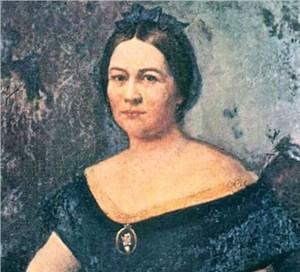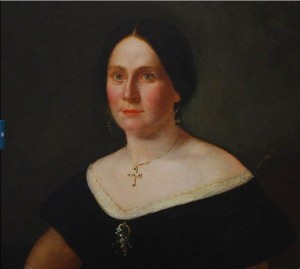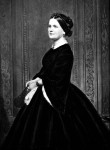A purported portrait of Mary Todd Lincoln by Francis Bicknell Carpenter that hung in the governor’s mansion in Springfield, Illinois for three decades turns out to be neither Mary Todd Lincoln nor by Francis Bicknell Carpenter. It’s a painting of an anonymous 19th century woman by an anonymous painter that was intentionally altered by a con man in 1929 to defraud the Lincoln family.


The con man in question was one Lew Bloom, né Ludwig Pflum, a sometime circus performer, vaudevillian and later art collector who was described in his obituary as having “dabbled in oil paintings.” He dabbled on that oil painting of an anonymous lady, darkening her hair and eyes, changing her facial features, painting over a cross pendant and adding a brooch with a miniature of Abraham Lincoln to make her look like an idealized portrait of Mary Todd.
Mr. Bloom concocted a story to accompany his handiwork, saying that Mrs. Lincoln surreptitiously approached Mr. Carpenter while he was at the White House working on his 15-by-9-foot painting, “The First Reading of the Emancipation Proclamation,” which hangs in the Capitol. She had planned a party, he said, where she would give the portrait as a surprise to her husband.
But, as the story went, after John Wilkes Booth shot the president at Ford’s Theater on April 14, 1865, the distraught and impoverished first lady asked Mr. Carpenter to dispose of it. Mr. Carpenter, Mr. Bloom claimed, sold it to a wealthy Philadelphia family, the Neafies, who in turn gave it to Mr. Bloom’s sister Susan, in thanks for her nursing a relative through a long illness.
He had this melodrama notarized to make it look official and everyone fell for it, most prominently Robert Todd Lincoln’s daughter Jessie. Her father had died in 1926. She was keen to rehabilitate his reputation which had long been sullied by the ugly aftermath of his attempt to have his mother committed to an insane asylum against her will in May of 1875. Illinois law at the time required a public insanity trial before anybody could be forcibly committed and the trial of the woman who had been First Lady to a martyred President just 10 years before was major news. A jury declared her insane after three hours of testimony and she was sent to Bellevue Place, by all accounts a nice rest home kind of place rather than the scary Victorian asylum one imagines.
 Still, Mary was a highly sympathetic figure to the public and Robert, who now controlled her finances, was seen as a heartless, greedy, unnatural son. That reputation was solidified three months later when Mary engineered her release by recruiting important politicians to come to her defense and planting stories in the press about her sanity and Robert’s cupidity. Mary died in 1882, still estranged from her son.
Still, Mary was a highly sympathetic figure to the public and Robert, who now controlled her finances, was seen as a heartless, greedy, unnatural son. That reputation was solidified three months later when Mary engineered her release by recruiting important politicians to come to her defense and planting stories in the press about her sanity and Robert’s cupidity. Mary died in 1882, still estranged from her son.
This wasn’t ancient history even in 1929. In late 1927, Robert’s widow Mary Harlan Lincoln was approached by the granddaughter of James and Myra Bradwell, a couple who had helped Mary Todd Lincoln bust out of the asylum, who planned to publish a book about Mary Todd based on her correspondence with the Bradwells. Mary Harlan Lincoln was so alarmed she paid $22,500, a huge sum at the time, to buy the manuscript and the original letters which she of course never published. (They survived, though, and were discovered by a historian in 2005.)
This is the context in which Mr. Bloom managed to scam Jessie Harlan Lincoln into spending thousands of dollars for a sentimental portrait of some random lady who even when repainted still didn’t look all that much like Mary Todd Lincoln. The family kept the painting until 1976 when Jessie Harlan Lincoln’s son Robert Todd Lincoln Beckwith donated it to the Illinois State Historical Library, now the Abraham Lincoln Presidential Library and Museum.
 The library had it examined by professionals at the Art Institute of Chicago who of course saw that it had been overpainted and that the lady underneath the retouchings didn’t look at all like Mary Todd, but they thought the overpainting was the work of sloppy restorers rather than deliberate fraud at the time of its sale. They wrote off the original portrait’s lack of resemblance to Mary Todd as an idealized view of the sitter. They restored the painting, revealing the cross but leaving the miniature of Abraham Lincoln, and then hung it in the governor’s mansion.
The library had it examined by professionals at the Art Institute of Chicago who of course saw that it had been overpainted and that the lady underneath the retouchings didn’t look at all like Mary Todd, but they thought the overpainting was the work of sloppy restorers rather than deliberate fraud at the time of its sale. They wrote off the original portrait’s lack of resemblance to Mary Todd as an idealized view of the sitter. They restored the painting, revealing the cross but leaving the miniature of Abraham Lincoln, and then hung it in the governor’s mansion.
Last year the library sent the painting to conservator Barry Bauman for cleaning. He delved further into the alterations and researched the history of the painting. He discovered Bloom’s dabbling hand and that whoever the sitter was, she wasn’t painted by Francis Bicknell Carpenter. He restored the painting to its original condition. She’s blue-eyed now and the Lincoln brooch is a little scroll of flowers. She won’t be returning to the governor’s mansion, but the library might put her up just because of the interesting backstory.
Too bad they “restored” it. It was more historical and interesting as a fraud than as what it was originally.
Bad choices made.
They should have noted the fraud, used imaging top prove it and left it alone. :no:
I gather there were condition issues to consider as well. You can tell from the 1965 picture that it was in bad shape then, and remember the 1976 restoration already removed some of the overpainting. I wish I could have found a picture from right after that work for comparison purposes.
Crime is almost as go :blush: od as history… but when it’s historical crime! :boogie:
Ignore the first smiley. Blasted phone.
I adore uncovering secrets of history, even things as simply deceptive as this. Who knows what other secrets linger below our noses!
Here’s to sniffing them out. 🙂